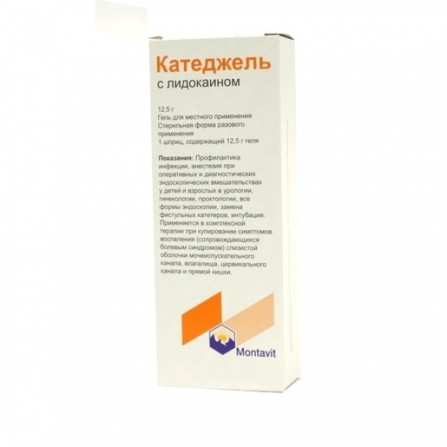Katedzhel with lidocaine gel in a syringe 12,5g 1pc
Condition: New product
990 Items
Rating:
Be the first to write a review!

More info
Active ingredients
Lidocaine + Chlorhexidine
Release form
Gel
Composition
100 g of gel contains: Active substance: chlorhexidine dihydrochloride 50 mg, lidocaine hydrochloride 2 g Additional substances: gietelloza (hydroxyethylcellulose) - 1.5 g, glycerol - 20 g, water d / and - up to 100 g. 12.5 g - syringes disposable polypropylene corrugated (1 ) with an extended and break off tip - blisters (1) - packs cardboard.
Pharmacological effect
The combined preparation for topical administration. It has an antiseptic and local anesthetic effect. Chlorhexidine is an antimicrobial drug acting on gram-positive and gram-negative microorganisms, yeast, dermatophytes. Effective against gram-positive and gram-negative bacteria - Treponema spp., Neisseria gonorrhoeae, Trichomonas spp., Chlamydia spp., Ureaplasma spp. Remains active (although somewhat reduced) in the presence of blood, pus, various secrets and organic substances. Lidocaine is a local anesthetic. Anti-microbial effect and adequate anesthesia develops 5-10 minutes after the drug is applied. with various endoscopic procedures.
Indications
- prevention of infection, anesthesia for surgical and diagnostic endoscopic interventions in children and adults in urology, gynecology, proctology, all forms of endoscopy, replacement of fistula catheters, intubation; , vagina, cervical canal and rectum.
Contraindications
- hypersensitivity to the drug.
Use during pregnancy and lactation
The drug should be used with caution in the first trimester of pregnancy. If used during lactation, you should refrain from breastfeeding for 12 hours after using the drug.
Dosage and administration
For slow instillation before insertion of instruments (by a doctor or specially trained personnel), it is necessary to: - open the blister by removing the paper from the transparent case (if possible only up to the waist); - break off the tip without considerable effort (if possible also in the package). It is necessary to ensure that the tip was completely removed, in order to avoid damage to the mucous membrane.To facilitate the insertion, it is recommended to pre-squeeze a drop of gel; -stillation by light pressure on the corrugated syringe. After emptying the syringe, it is necessary to keep it in a compressed state before withdrawal. The introduction of the instruments is recommended 5-10 minutes after the instillation of the gel.
Side effects
Allergic reactions: in case of hypersensitivity allergic dermatitis, skin rash, angioedema may occur. Local reactions: burning at the site of application.
Overdose
Symptoms (with systemic action of lidocaine in cases of severe damage to the urethra): bradycardia, convulsions, collapse. Treatment: with bradycardia, beta-adrenergic stimulants, with convulsions, barbiturates or short-acting muscle relaxants, with collapse, epinephrine or dopamine is administered in / in.
Interaction with other drugs
Avoid joint use with iodine preparations. MAO inhibitors enhance the local anesthetic effect of lidocaine. Pharmaceutical interactionIs incompatible with soap and detergents containing an anionic group (saponins, sodium lauryl sulfate, sodium carboxymethylcellulose). Compatible with drugs containing a cationic group.
special instructions
The drug is sterile and intended for a single injection. Regional and local anesthesia should be carried out by experienced professionals in a properly equipped room with the availability of ready-for-use equipment and preparations necessary for monitoring cardiac activity and resuscitation. Anesthesia personnel must be qualified and trained in the technique of anesthesia, must be familiar with the diagnosis and treatment of systemic toxic reactions, adverse events and other complications.





